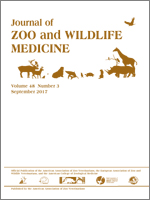A 3-yr-old Asiatic black bear (Ursus thibetanus), weighing 68 kg, underwent a laparoscopic-assisted placement of a ventriculoperitoneal shunt for hydrocephalus in the Lao People's Democratic Republic. Rescued as a young cub with a notably domed head, the bear's condition had deteriorated with age, but euthanasia was not a viable option because of cultural issues. Surgery was attempted as a palliative measure. The bear had ventrally orientated crossed eyes (abducens nerve palsy and dorsal midbrain syndrome), papilledema, severe rhinorrhea, depressed mentation, lethargy, a very poor appetite, and was stunted. Hydrocephalus was confirmed via intraoperative 2.0–5.0 MHz head ultrasound, as no magnetic resonance imaging was available in the country. Surgery was planned via 3D modeling of museum skulls and brain cavity, and ultrasound examination of formalin-preserved brains of other carnivores with hydrocephalus. The bear demonstrated a notable improvement in mentation, appetite, and behavior, maintained for 4 yr following surgery.
How to translate text using browser tools
1 September 2017
LAPAROSCOPIC-ASSISTED INSERTION OF A VENTRICULOPERITONEAL SHUNT IN A RESCUED ASIATIC BLACK BEAR (URSUS THIBETANUS) IN LAOS
Romain Pizzi,
Jonathan Mark Cracknell,
Andrew C. Kitchener,
Nev Broadis,
Denise Laughlin,
Kirsty Officer,
Yolanda Martinez Pereira,
Matt Hunt
ACCESS THE FULL ARTICLE
bear
Endoscopy
hydrocephalus
laparoscopy
surgery
wildlife





